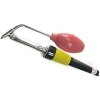A couple of months ago one of the cameras in my LTS 8932-16p lost its video feed. This NVR has 16 POE built in and I have 16 cameras connected to them.
In live view the affected camera showed "VIDEO LOSS" and there were no recordings from that cam. Then a few days later another one went down. Then other cameras would intermittently do the same. Some cameras would come back for awhile and some just stayed "loss".
Now I'm down to just three. It's been over a week and there as been no changes. What weird is that most of the "loss" cameras started from the higher number POE ports.
I googled my symptoms but couldn't find anything. However, I did find a guy on YT showing how to test the diodes for loss video. He said if they are shorted, then they're bad. But I tested all my diodes and none of them were shorted.
However, as I was over the board carefully looking for any burnt marks I noticed some of the capacitors (my friend Google told me) didn't look right. There were some with orange stuff on the bottom and some with rounded tops.
I hope these are the culprits, as I couldn't find anything else wrong with the board. Does anyone know by looking at them that they are definitely the culprits. How easy are they to replace? What should I look for, besides matching the numbers, when buying replacements? I have a soldering iron but it's been ages since I last used it.
Any suggestions would be appreciated.
Derek





Sent from my SM-S901U using Tapatalk
In live view the affected camera showed "VIDEO LOSS" and there were no recordings from that cam. Then a few days later another one went down. Then other cameras would intermittently do the same. Some cameras would come back for awhile and some just stayed "loss".
Now I'm down to just three. It's been over a week and there as been no changes. What weird is that most of the "loss" cameras started from the higher number POE ports.
I googled my symptoms but couldn't find anything. However, I did find a guy on YT showing how to test the diodes for loss video. He said if they are shorted, then they're bad. But I tested all my diodes and none of them were shorted.
However, as I was over the board carefully looking for any burnt marks I noticed some of the capacitors (my friend Google told me) didn't look right. There were some with orange stuff on the bottom and some with rounded tops.
I hope these are the culprits, as I couldn't find anything else wrong with the board. Does anyone know by looking at them that they are definitely the culprits. How easy are they to replace? What should I look for, besides matching the numbers, when buying replacements? I have a soldering iron but it's been ages since I last used it.
Any suggestions would be appreciated.
Derek





Sent from my SM-S901U using Tapatalk



